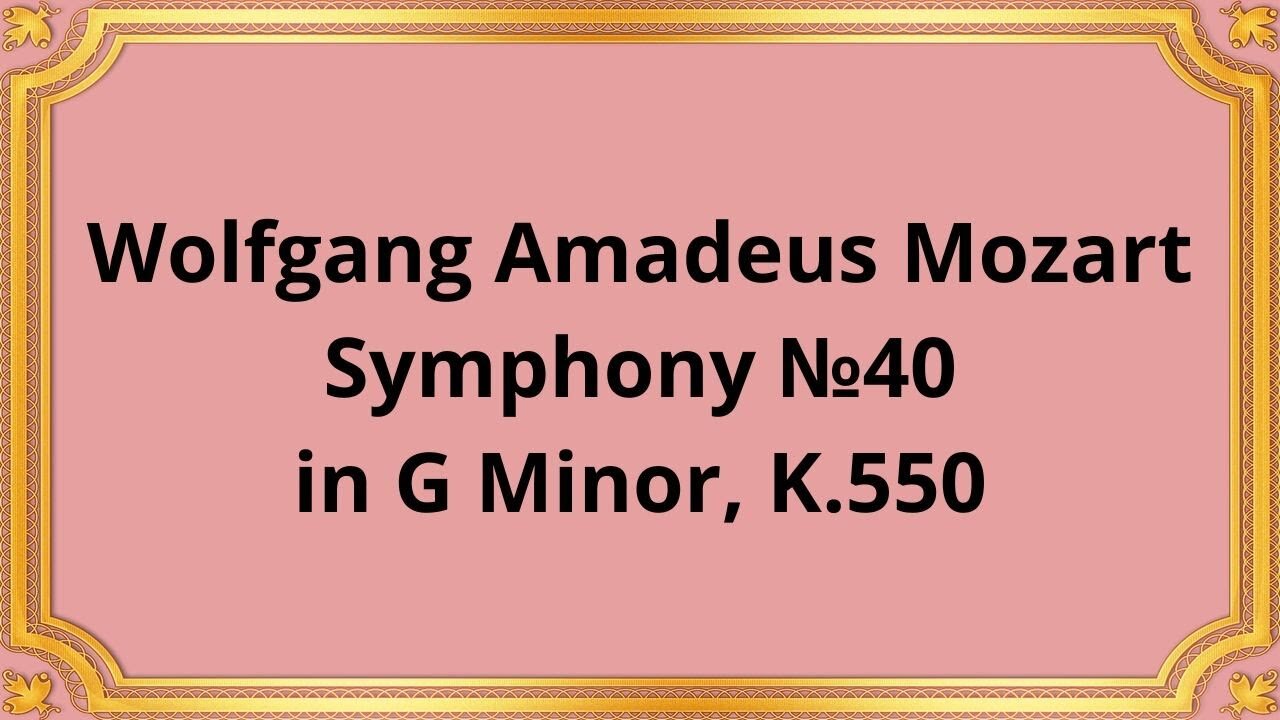Premium Only Content

Wolfgang Amadeus Mozart Symphony №40 in G Minor, K.550
#WolfgangAmadeusMozart #SymphonyNo40 #GMinor #K550 #ClassicalMusic #MusicalComposition #MozartSymphony #SymphonyInGMinor #ClassicalComposer #ClassicalEra #OrchestralMusic
Publication date 1957
ROCHESTER ORCHESTRA
ERICH LEINSDORF, Conductor
Wolfgang Amadeus Mozart, a legendary composer of the classical era, left an indelible mark on the world of music. Among his numerous masterpieces, Symphony No. 40 in G Minor, K.550 stands as a testament to his unparalleled genius.
Composed in 1788 during the final years of Mozart's life, Symphony No. 40 showcases the emotional depth and complexity that characterized his late works. The classical era was a time of enlightenment and artistic refinement, and Mozart's symphony reflects this spirit, embodying the ideals of balance, clarity, and elegance that defined the period.
Symphony No. 40 consists of four movements, each displaying Mozart's mastery of form and his ability to evoke a range of emotions within a cohesive musical structure.
1. Movement I (Molto allegro):
The symphony opens with a vigorous and dramatic introduction, immediately captivating the listener. The main theme, characterized by its ascending and descending chromatic lines, creates an atmosphere of tension and urgency. Throughout the movement, Mozart skillfully contrasts moments of darkness with passages of lyrical beauty, showcasing his ability to navigate between emotional extremes.
2. Movement II (Andante):
In stark contrast to the first movement, the second movement unfolds with a serene and melancholic melody. The gentle strings, accompanied by the woodwinds, evoke a sense of introspection and longing. Mozart's use of chromatic harmonies adds depth and richness to the composition, resulting in a hauntingly beautiful movement.
3. Movement III (Menuetto - Trio):
The third movement, a minuet and trio, serves as a lively interlude within the symphony. The minuet, characterized by its graceful dance-like rhythm, is juxtaposed with the contrasting trio section, featuring a more delicate and melodic theme. This movement showcases Mozart's ability to create dynamic contrasts and maintain a sense of cohesion within a larger musical structure.
4. Movement IV (Allegro assai):
The final movement bursts forth with a sense of urgency and energy. The driving rhythm and virtuosic passages highlight Mozart's compositional brilliance, as the symphony reaches its climactic conclusion. The recurring themes from earlier movements are skillfully woven together, creating a sense of unity and resolution that leaves a lasting impression on the listener.
Mozart's Symphony No. 40 in G Minor, K.550 has stood the test of time, captivating audiences for centuries. Its emotional depth, technical brilliance, and impeccable craftsmanship continue to inspire and influence musicians and composers to this day. The symphony's melodic richness, harmonic complexity, and dramatic intensity make it a cornerstone of classical music repertoire.
Conclusion:
Wolfgang Amadeus Mozart's Symphony No. 40 in G Minor, K.550 is a musical masterpiece that showcases the composer's exceptional talent and artistic vision. Its historical significance, coupled with its intricate musical structure and profound emotional impact, have solidified its place in the pantheon of classical music. As we continue to appreciate and study this timeless work, we gain a deeper understanding of Mozart's genius and his unparalleled contribution to the world of music.
You have the opportunity to support the channel:
https://destream.net/live/RadSiarAl/donate
https://www.buymeacoffee.com/6355radsiaral
-
 20:26
20:26
Classical music_Music Inspiration
1 month agoJohann Sebastian Bach Orchestral Suite No. 2 in B minor, BWV 1066
772 -
 LIVE
LIVE
RalliedLIVE
4 hours ago $1.27 earned10 WINS WITH THE SHOTTY BOYS
91 watching -
 1:14:33
1:14:33
Dr. Drew
5 hours agoBenny Johnson & Mama June: America & Families In Crisis w/ Pumpkin & Jessica (The Double Feature Nobody Expected) – Ask Dr. Drew
2.65K -
 4:00:56
4:00:56
Viss
4 hours ago🔴LIVE - How to Consistently Win in PUBG!
5091 -
 LIVE
LIVE
StoneMountain64
5 hours agoHIDE AND SEEK. IM GOING TO FIND YOU.
48 watching -
 13:40
13:40
Preston Stewart
6 hours agoMajor Protests Erupt in Ukraine
405 -
 LIVE
LIVE
LFA TV
19 hours agoLFA TV ALL DAY STREAM - WEDNESDAY 7/23/25
1,472 watching -
 LIVE
LIVE
sophiesnazz
2 hours agoI AM BACKK !socials
8 watching -
 LIVE
LIVE
The Rabble Wrangler
13 hours agoRimworld with The Best in the West!
49 watching -
 19:16
19:16
Clownfish TV
12 hours agoColbert Calls Himself a MARTYR and Tells the President to GO F HIMSELF!
1.1K17